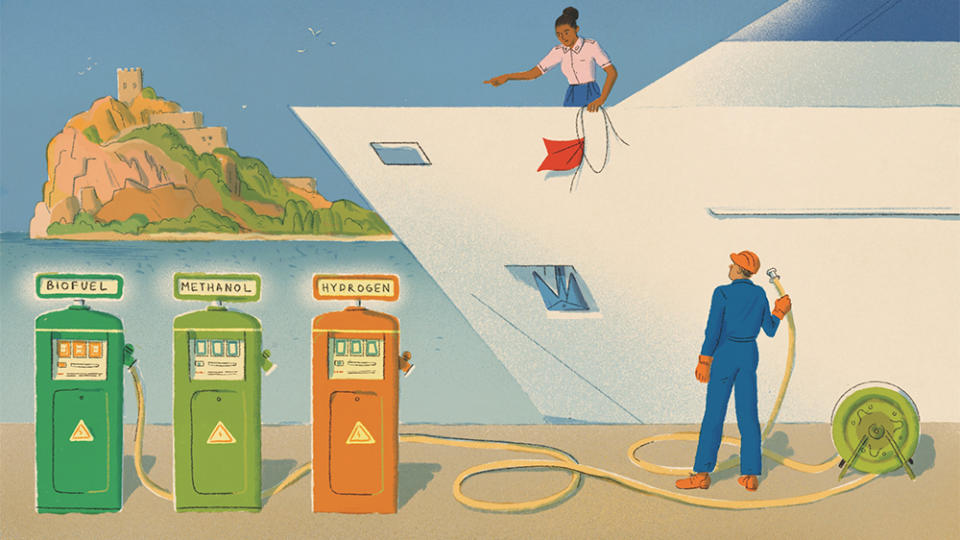Will that be methanol, biofuel, or hydrogen for your superyacht? It’s something you might hear at the fuel dock in the not-so-distant future. That’s because builders have essentially been pushed onto a carbon-neutral timeline. “Both the International Maritime Organization (IMO) and European Commission are asking for drastic carbon reductions,” says Paolo Bertetti, vice president of research and development for Sanlorenzo Yachts, of cuts that could be as much as 40 percent by 2030 using the IMO framework. “At the same time, environmentalists are also targeting us.”
This scenario has prompted three approaches to cleaner propulsion: hydrogen fuel cells for yachts under 79 feet, green methanol converted to hydrogen for larger vessels, and hybrid diesel power acting as an interim solution for both categories. The last uses hydrotreated vegetable oil (HVO), which emits 90 percent fewer carbon emissions than diesel but can be used in conventional engines.
More from Robb Report
High-tech motorboats powered by hydrogen fuel cells, batteries, and electric motors are already on the water, courtesy of the America’s Cup and its 33-foot chase boats. Emirates Team New Zealand was first with its foiling tender, Chase Zero, followed closely by American Magic’s HV3, designed and built by Sanlorenzo’s Bluegame brand. Both craft use the same hydrogen-producing Proton Exchange Membrane technology that helps power Toyota’s Mirai EV. In the boats, the tech delivers 50-knot top speeds, 550-pound payloads, and 180 nautical miles at 27 knots.
“Powerboats like ours, and smaller yachts, will be dependent on how fast the automotive market develops this technology,” says Luca Santella, Bluegame’s head of product strategy. “If it moves fast and we see infrastructure coming to marinas, hydrogen could be more than a niche in five years.”
Sanlorenzo has committed to delivering a 165-footer with a hydrogen fuel cell supporting the yacht’s “hotel” load (infrastructure not related to propulsion) by 2024, with a bi-fuel version (methanol and diesel) for propulsion before 2030. “That second stage includes more powerful fuel cells that handle internal power and propel the boat up to nine knots,” Bertetti says.
Lürssen has been experimenting with alternative fuels since 2005, but the company hopes its methanol-based 375-foot Project Cosmos, on schedule to be delivered to its owner in 2025, will be a game changer. The shipyard set up a lab, in collaboration with Freudenberg, specialists in maritime fuel cells, to test the methanol fuel cell. A successful Cosmos could convince other clients that methanol is the first step toward a carbon-neutral superyacht.
“We have the technology, but need the right owners,” agrees Gianluca Ciniero, engineering manager for the superyachts division of the Ferretti Group, which, in collaboration with Weichai Power Science, designed diverse engine platforms for two size ranges of superyachts that will rely on methanol. Besides being more complicated than a conventional diesel setup, the new design will need to accommodate methanol fuel tanks.
One prime directive underlies all this engineering: It should have minimal impact on interior spaces typically used for recreation or accommodations. “We do not want to lose areas devoted to the owners,” says Ciniero of the challenge.
Deleting a stateroom or cinema in the name of fuel storage could be trouble, agrees Simon Brealey, chief mechanical engineer for Lateral Naval Architects. The U.K. firm recently debuted its Energy Transition Platform, a concept that retains roughly the same interior footprint but allows the yacht to be retrofitted as new propulsion technologies come online. “If you’re building a superyacht, don’t ignore this,” says Brealey, noting that future emissions regulations and new advancements could make diesel power obsolete.
“Biofuels like HVO will be a good solution for the medium term,” says Alessandro Rossi, chief technical officer for the Azimut-Benetti Group. According to Rossi, incremental gains in hybrid diesel-electric, especially from improved batteries and advances in heat recovery, will get the job done as the alternative fuel-cell technologies continue to develop. Many predict that technology could take a decade to become mainstream.
For now, hybrid power and HVO will be the key to lowering emissions, especially in smaller yachts. Rossi notes significant advances since its first hybrid diesel/electric offerings 15 years ago. “The difference from then to now in our hybrids is dramatic,” he says.
Despite the allure of carbon-free yachting, experts agree that it will take time to mainstream alternative- propulsion types, mostly because there’s currently no infrastructure for them in marinas. Rossi believes methanol will eventually be the future for superyachts, but with one caveat: “We need to get ready first.”
Best of Robb Report
Sign up for Robb Report’s Newsletter. For the latest news, follow us on Facebook, Twitter, and Instagram.
Click here to read the full article.
Credit: Source link
